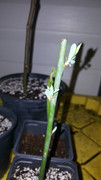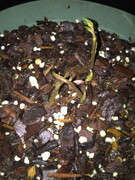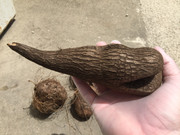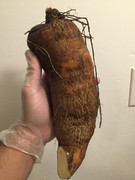Hi all, I'm writing up this thread to update y'all on the story so far with my non-solanaceous potatoes. First, the Potato Mint (P. rotundifolius):
The plant was vigorous almost from the start. It arrived early in the year as a tall and kinda weak-looking fully-rooted cutting from a Florida eBay vendor, and I planted it in one of those big plastic tubs with holes drilled in the bottom. I also planted a Guinea Yam (Dioscorea rotundata) in the same tub.
A week after planting and the potato mint already had plenty of strong growth. A month after planting, and it had already taken over the entire tub's surface area with foliage, and some branches were bending toward the soil and taking root. A few weeks later, and it was spilling out of the tub and onto the surrounding ground, so I decided to give it a drastic pruning, leaving behind a few stumps... In hindsight, that was probably a poor decision as the growth of new foliage would probably take vital energy and nutrients away from tuber growth. Lesson learned. I threw some tomato seeds onto the newly-exposed soil surface and forgot about them.
A few weeks afterwards, and the growth was carpeting the tub again, and the pruned stems I had thrown on the ground had taken root and started growing on their own (I left them there and they keep growing to this day). The surviving tomato plants grew tall between the potatoes, and soon both species started flowering simultaneously. A few weeks afterwards, with the tomatoes producing and the potatoes' flower spikes starting to fade (which means harvest time), I pulled up one of the potato plants and dug up the tubers.
Given the various less-than-ideal circumstances (container-growing, competing plants, partial shade, no fertilizer, impromptu heavy-pruning) the crop was small (and composed of mainly smaller tubers), but I'm confident it would've been a good crop under better circumstances. The biggest (normal-sized?) ones were about the size of a small potato, but many were smaller (like Lerén tubers), and a score of them were tiny (these I saved for re-planting). Even with a suspected smaller crop, I actually got enough potatoes out of that one mistreated plant to have a full plate of mashed potatoes. I pulled the remaining plants out the next week and had them fried.
The tubers were amazingly easy to process, so that even pinky-sized tubers were quickly dealt with and used. I put on a pair of gloves, and scratched the skin off under running water quickly during washing off the dirt. In fact, while the nails may have slightly sped up the process, it probably wasn't necessary, as the skin rubbed off with the soft part of the fingertips, it was that tender!
The tubers were white, but many had large areas of green under the skin, and a few had purple areas (all from the same plant). I was unconcerned with toxicity as I'm pretty sure the entire plant is technically edible and non-toxic. After boiling like normal potatoes, I tasted a few whole and mashed the rest. The taste was really very close to true potatoes, with a slight vegetal tone my family likened to Artocarpus camansi seeds (the very mild, immature ones, not the strongly-flavored ripe ones), but milder still. No purple remained after boiling and there was no bitterness or any discernible difference between the green and white areas. I should also point out that some sources mention a sweetness to the taste... I detected no such sweetness (nor any minty/peppery/spicy taste), it was just potatoey.
The second batch of tubers was prepared for frying. Some were left skin-on (I recommend it, though it requires delicate washing), many were sliced lengthwise, a few sliced into chip shape, and a few smaller ones were fried intact. Crispy outside, soft inside (even the chips were a bit flexible), and the flavor was like a combination of homemade french fries and fried eggplant (the good types; no bitterness). They were very good, and doubtless would've been excellent seasoned and roasted like wedge potatoes.
The verdict: unknown prospects as a commercial root crop (especially given how easily the skin rubs off), but excellent for the home vegetable plot. Vigorous and nearly care-free, probably productive (especially with good care and space, not like my neglect), easily propagated, easily processed, and of good taste. I highly recommend it for any warm-weather vegetable garden (no idea if it has a short enough growing season for cooler regions).
***
Now the Edible Air Potato (D. bulbifera):
I received 7 bulbils through the combined efforts of Chandramohan and Roy. They were quick to sprout through the dirt, the last of them a few weeks after planting. Each bulbil sprouted several vines, and would continue sprouting more throughout the growing season. Alas, my crime of neglect was worse with these, and I'm probably not witnessing full production (even though it still seems like a vigorous producer). For my current lack of space, I transplanted every single one of those plants (together with a Chinese Yam, D. polystachya) into a single tub that was probably only big enough (but not ideal) for just two plants; one trellis shared between them.
Despite the circumstances, they also grew vigorously (and twined together), and all seven plants are alive and well. Months passed without a single bulbil (it's not supposed to bear until close to the end of the growing season anyway). Then one day I saw a small bulbil, and it remained alone, increasing in size until almost reaching its maximum (small potato, but bigger than the P. Mint) long before any other bulbils showed up. When others showed up, it was an almost explosive profusion of bulbils, with a rough count of approximately 47 (which I'm fairly sure fell short of the true number even then; by now, many more still have showed up).
All was well and good, to a point, but there's an important thing to mention about this plant: it seems far more susceptible to animal pests than any other yam I've grown. Nothing of note has ever touched any of my other yam vines. Meanwhile, I've seen bulbifera leaves eaten by crickets, cockroaches and snails (and possibly a grasshopper and a katydid, but I didn't see them chewing). And the worst part: the snails ruin the bulbils themselves! I saw one with a gaping hole that looked like a bird pecked into it, thinking it was a fruit. For a while, that's exactly what I thought. But one night I decided to check on the plants at midnight and I started seeing the different pests in action. A week later, I saw the snail on the bulbil, and a second one on another one, rasping holes right through them. Suffice it to say that I've been hunting snails often since then, and crushing every one I find. But the damage was done: in a blind panic, I harvested the big one for fear that a snail would get to it first.
Strictly speaking, I'm not certain that you're not supposed to harvest them, but I was under the impression that you're meant to leave them on the plant until they drop off naturally. A friend (who has harvested alata bulbils) told me that if you pick them before their time, the flesh would be green, and they'd be inedible. Well wouldn't you know, when I went to cook the big one, it was green all the way through. Peeled so that I couldn't plant it, and seemingly too green to be edible, I had to throw it out. Crushing disappointment after all that waiting. Oh well, I've waited this long, I can wait longer for the other bulbils to ripen. I plucked a few small ones from a drying vine to propagate them, but the few big ones I've seen look like they have a few months to go before they drop. I'm hoping the little ones grow quickly, so I can get a half decent crop when it's time to taste them. I truly have high hopes for this plant, and will give my usual play-by-play analysis when I taste them (probably some time next year).
***
Photo Gallery:
The African Potato / Potato Mint:



Same, boiled, mashed and fried:


The Air Potato:




Snail damage:



The big one:























































